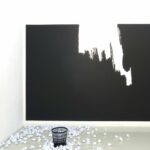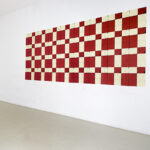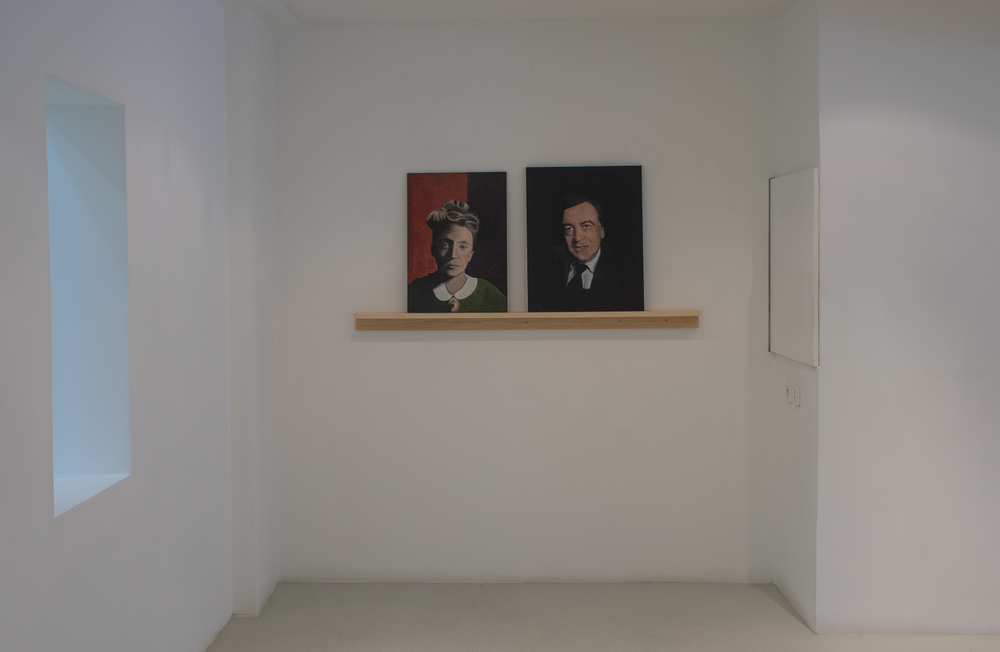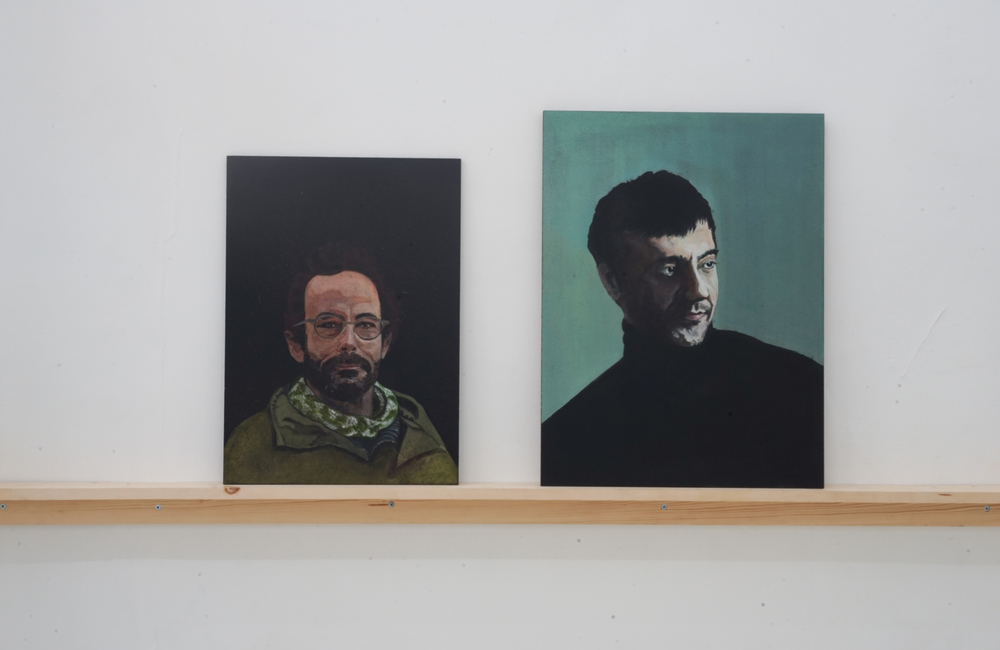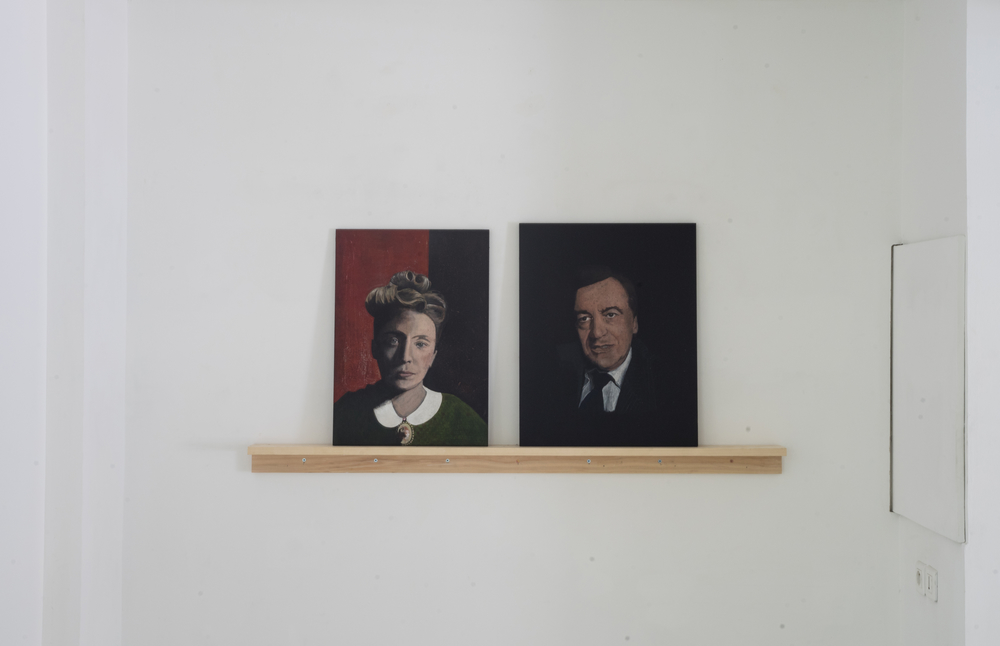Sandra D.Lecoq
Autoportrait des autres en noir
Portraits of a Lady
Opening night rue Vernier. Ayant poussé les portes grandes ouvertes de la galerie Eva Vautier vous tombez nez à nuque sur une photographie grand format de Sandra Lecoq, de dos. Dans cette photo, Sandra Lecoq, transfigurant son quotidien, s’est mise en scène, en faisant de ses chiffons d’atelier une immense robe nuptiale rapiécée et souillée : la mariée était en crade. Elle y est une sorte de grande perche, cariatide en pleine crise de croissance, Alice au pays des emmerdes envahissant l’espace de bas en haut. Si vous souleviez son jupon, vous la verriez, petite maline, juchée au sommet d’une pile de modules de peinture empruntés à une photo de 2016 : Haut les cœurs et bas de plafond dont Peau d’âme est une sorte de double inversé. Sur la photo de 2016 qui a servi à l’exposition collective chef-orchestrée par Karim Ghelloussi, Le monde ou rien, elle figurait en tablier, disparaissant sous une pyramide de briques multicolores et équilibristes. La fille en bleu de travail, c’est elle, la poupée de foire à crinoline, c’est encore elle. Ouvrière ou reine, écrasée ou dominant la situation, voici plus de vingt ans que Sandra Lecoq est mariée à son art salissant (robe = chiffon, tableau = palette). Dans les deux photos, la salle de bal est l’humble rectangle carrelé de son atelier – son luxe, dit-elle –, un module en abyme dans un bâtiment où l’on abat de la besogne, une case comme une salle de classe où chaque jour on désapprend. Ce n’est pas l’espace qui est trop bas de plafond mais la tâche qui est immense, ce n’est pas contre les murs qu’elle se cogne mais contre autre chose. Si le temps d’un cliché ou deux, Sandra Lecoq entrouvre sa fabrique, ce n’est pas pour livrer ses secrets ni pour témoigner – son travail n’a aucune visée documentaire – mais davantage pour afficher le lien qui l’unit à un groupe d’artistes, voisins d’atelier, amis, compagnons de route, une petite communauté d’esprit de mousquetaires-artistes. Florent Mattei prend la photo pour Sandra Lecoq, Karim Ghelloussi l’expose et ainsi de suite, une pour tous, tous pour une. Cette économie participative et complice a notamment donné naissance à cette photographie, Peau d’âme et avanti jaddu ! (le coq en sicilien…) qui ouvre la nouvelle mostra de Sandra Lecoq en faisant du peintre le modèle.
Un renversement qui est sans doute une clé pour appréhender ce qui suit. Car nous qui entrons, abandonnons toute certitude. Prenons-nous par la main et passons de l’autre côté. Une forêt de portraits, une galerie des glaces, c’est ce que nous allons traverser : trente visages graves qui forment une étrange parentèle. Vous disposeriez tout autour des lambris, un plafond à caissons, du papier damassé, une rampe en chêne vous n’en seriez pas moins dans la cage d’escalier grinçante d’une maison de maître où les gueules d’enterrement dans leurs cadres dorés le disputent aux trophées de chasse. Comment se sont-ils retrouvés ici ? Accrochons-nous à la rampe et avanti jaddu !
L’effet de surprise pour ne pas dire de sidération est multiple. On assiste à une rétrospective de travaux jamais montrés. Seuls ceux qui fréquentent à Nice le quartier du port et ses bouges ont pu en voir quelques-uns sous couvert d’anonymat dans le cadre d’une avant-première qui n’a jamais eu lieu. Quand on demandait au gardien occasionnel de ce musée éphémère : « Mais de qui sont ces toiles ? », le préposé ôtait sa casquette et vendait la mèche : « Sandra Lecoq ». Je vous prie de croire qu’on pouvait lire l’étonnement et l’admiration sur le visage des curieux. Car il faut se souvenir que l’histoire de Sandra Lecoq avec la peinture est celle d’un rendez-vous différé, devenu quasi impossible à force de retard. Que disait l’intéressée ? « Mère Peinture implorée si longtemps m’avait déçue, trop intransigeante, trop dure. » Que disait la gazette ? « Chez elle la couleur se tresse, se coud, se confectionne. Au pinceau se substitue l’aiguille, les bouts de tissus font de bons aplats. » Ou encore : « Sandra D. Lecoq appartient à une génération d’artistes qui relève le défi de la peinture du côté de l’objet. S’il n’emploie pas les outils, les supports et les médiums traditionnels de la peinture, son travail procède bien simultanément du dessin et de la couleur. »
Il serait faux de dire que Sandra D. Lecoq n’a jamais peint, il suffit de se reporter à la série H de guerre (2007), toiles mêlant écriture (gros mots) et variation sur les gestes picturaux où l’insulte signifiait aussi le combat qu’elle livrait avec la peinture. A l’époque, personne n’aurait imaginé qu’elle franchirait le pas, peindrait sur toile ou sur bois, à l’acrylique et à l’huile, des portraits qui seraient ensuite poncés, cirés, patinés et finalement exposés. Pour autant voici vingt ans que l’idée de la peinture est là. Son portrait-hommage de Gérard Gasiorowki (1930-1986) pourrait être une forme d’aveu. Elle perçoit dans la manière iconoclaste et hétéroclite du peintre ayant fait l’oblation de lui-même à son art, un jusqu’auboutisme dont elle veut se réclamer et qui lui permet aujourd’hui de franchir ce pas.
Dans cette vie qui n’est pas toujours un cadeau, il a fallu un geste qui en soit un. Comme un signal de départ. A un être chéri, fasciné par ces tableaux d’ancêtres où l’encadrement vaut souvent davantage que l’œuvre, elle a voulu un jour offrir un portrait, un beau portrait des familles. Faute de moyens, elle s’y est mise, comme une grande. Amour est un bon guide et, en art, l’intuition peut tenir lieu de technique. Ce jour-là, dans le secret de l’atelier, elle a trouvé l’élan, bientôt suivi du geste de peinture. Oui, elle s’est lancée, puis elle a multiplié les tentatives.
A l’exception de deux ou trois portraits nés de son imagination, dont ce type, prétendument inspiré de Florent Mattei, avenant comme un paysan amish façon Grant Wood, Sandra Lecoq peint ses portraits d’après photos, photos de proches ou piquées dans des livres et sur le Net. Une photo, c’est-à-dire un petit morceau d’abstraction qu’elle va révéler. Et c’est ainsi qu’elle s’est jetée à corps perdu dans l’aventure du portrait, à l’instinct, avec sa manière qui pour ne pas être conceptuelle n’est pas non plus tout à fait non-conceptuelle. Pour faire ses portraits, elle n’a pas voulu apprendre la technique du portrait comme elle n’a pas voulu étudier l’histoire du Fayoum à nos jours pour tirer à son avantage un propos intelligent sur l’art du portrait. De toute façon, elle fait tout ce qu’il ne faut pas faire, c’est dans sa nature. Elle dit qu’elle fait et réfléchit après. Que voulez-vous, certains lisent entièrement le mode d’emploi et d’autres préfèrent appuyer sur tous les boutons. Ça ne marche pas toujours mais quand ça marche, quelle fulgurance, quelle fête. Revers de la médaille : la victoire de l’intuition oblige à chaque fois à repartir presque de zéro, à réessayer toujours, soleil qui s’élève le jour pour plonger le soir sous l’horizon, tel est Sisyphe.
L’aventure a commencé il y a mettons deux ans et elle n’est pas finie, nous n’en sommes qu’à la première saison d’une nouvelle série. Elle a intérêt à vous plaire car vous pourriez en prendre pour un bon moment. L’œuvre de Sandra Lecoq ne connaît pas à proprement parler de ruptures, pas d’époques, de périodes rose, bleue, marronnasse, si elle interrompt ses travaux, elle ne coupe jamais complètement le fil et reprend son ouvrage où elle l’avait laissé, sans éclats ni effets d’annonce, sans tralala, elle n’a pas le temps, c’est une bosseuse. Elle se dit sauvage mais elle peut être mondaine, comme vous et moi, elle aime se taire autant que beaucoup parler. Elle est de toute façon trop modeste ou trop immodeste pour se reconnaître une qualité quelconque. Si on se permet ici de parler d’elle, ce n’est pas pour esquisser son portrait mais pour rappeler qu’on n’est pas à une contradiction près et que la contradiction en soi peut être un sujet : les autres.
Une famille en noir est un jeu visuel, la télé-réalité de l’artiste, au sens d’une œuvre de télépathie et de sympathie revenant à dire qu’on est la somme des autres. (Qui en doutait ?) Dans cet Autoportrait des autres – clin d’œil à Gertrude Stein où Lecoq-Toklas s’efface et se démultiplie pour mieux partager sa chambre d’échos – on est libre d’admirer sans entrave, de rendre hommage, célébrer, libre d’aimer sa famille ou de s’en choisir une autre, d’appartenir à un tout, de s’y fondre ou de lui dire merde. Le cerveau est une malle pleine de gens. Les autres sont dans la tête de l’auteur et les visages peints un jeu de reflets de la conscience. Résultat : une trentaine de tableaux presque tous nimbés de noir, une enfilade de portraits saturniens qui barrent d’une ligne sombre des parois que la blancheur défend. Trente médaillons qui, sur leur quant-à-soi, se toisent, roulent des yeux et dans leur nuit se parlent.
Trente glorieux et glorieuses, il faudrait toutes et tous les nommer, on ne va pas le faire, ils ne sont désignés ici que par leur matricule. Après tout, de quoi est-on le nom ? Lecoq, Elle le sait au
cul (2007), ça vous parle ? Parmi eux, certains sont nés au xixe siècle, tel le père de la psychanalyse (SF 0056) ou encore l’auteur de La Traversée des apparences (VW 0082), le plus jeune a 17 ans, c’est le fils de l’artiste (LD 099). Or sur chacun de ces portraits poudroie la lumière d’un temps incertain. C’est un portrait de groupe disloqué : autour de la table, les époques, les âges, les sexes, les races se sont fixé rendez-vous par la seule volonté du peintre. Ne pensez-vous pas que les hommes en noir d’un Fantin-Latour ont davantage à se dire séparément qu’ensemble ? (D’ailleurs voit-on jamais ses tableaux en entier ?) Les portraits sont des miroirs qui approfondissent la perspective aussi bien spatiale que temporelle. Leur juxtaposition en nombre fait qu’on échappe à linéarité du temps, c’est davantage une somme accidentelle d’univers, de territoires et de destins. On passe ainsi des vivants aux morts, de l’imaginaire au réel. Ces portraits réalistes, reprenant même pour certains des représentations iconiques et galvaudées (Lacan, Kahlo, Cassavetes, Woolf, Pasolini), sont, par la force des choses, une entorse au réel, le peintre peint ce qu’il voit. Cela vient aussi de ce que les miroirs, appelons-les portraits, de Sandra Lecoq sont des instruments de désir – Eh oui ! l’éternel combat (perdu d’avance) entre Eros et Thanatos. Il en ressort une érotique en habit très particulière, surtout pour celle qui, par ailleurs, n’a jamais craint de montrer son truc très doux (2008), des Penis Carpets (des années de pratique !), l’interpénétration mouvementée de Phallus et Vanité (2008) ou tout le folklore du Vit en rose (2007) qui valut à la coupable d’être censurée.
Le miroir des autres est l’occasion d’un retour sur soi, d’une introspection, d’une prise de conscience. Une conscience politique aussi bien. Il y a Simone Weil (SV 027) : l’avortement. Cédric Herrou (CH 079) : le paysan de la Roya, passeur et symbole de l’aide aux migrants. Leoluca Orlando (LO 047) : le maître de Palerme ouvrant sa porte aux réfugiés dans une Europe fermée. Il y a Pasolini (PPP 022). L’Orestie africaine de Sandra Lecoq se situe au Cameroun où elle est née en 1972 et emprunte les traits tragiques de Ruben Um Nyobe (RUN 013), assassiné en 1958 (45 ans) par l’armée française, et Félix-Roland Moumié (FRM 025), assassiné en 1960 (35 ans) par les services secrets français, deux figures de la lutte pour l’indépendance. Ces leaders salement éliminés, elle ne les a pas plus connus que la jeune morte Eva Hesse (EH 036) ou la quasi centenaire Louise Bourgeois (LB 011) mais ils sont aussi son histoire.
Ce portrait de groupe ou ce groupe en portraits, c’est enfin l’occasion, dix ans après, de décliner une expérience qui avait frappé les esprits à Nice, l’exposition du Dojo : Délicieux cadavres exquis ou l’histoire d’une sainte famille recomposée. Un événement salué en ces termes par Jean-Marc Réol :
« Nulle trace ici d’un exposé thématique sur une question de l’actualité de l’art, nulle interrogation socio-historique sur le rôle politique des artistes, mais plutôt l’expression, tour à tour enjouée et enthousiaste, d’un désir d’exposer le lien qui unit un groupe d’artiste, sur un mode essentiellement affectif et ludique. A cette « sainte famille » appartenaient Noël Dolla, Roland Flexner, Philippe Mayaux, Pascal Pinaud, Philippe Ramette, Olivier Bartoletti, Karim Ghelloussi. ND 045, RF 044, PM 061, PP 064, PR 061, OB 073, KG 077 : on les retrouve tous ici en peinture dans cette conversation piece. La commissaire de l’exposition de 2006 a trouvé en 2017 l’art et la manière de réunir à nouveau son petit monde.
Soir de juin, après un verre du jaja de Ben, la température monte d’un cran. Ces cartons d’invitation 15 x 21 sont des éventails bien pratiques : au recto, une photo de l’artiste de dos, le dos de l’artiste s’est fait toile et châssis, son plus jeune fils lui dessine à même la peau une poulette, à moins que ce ne soit un coq, tandis que le fils aîné prend la photo. Le tout est un autoportrait de l’auteur réalisé en famille. Le noir s’est changé en or.
FM 067
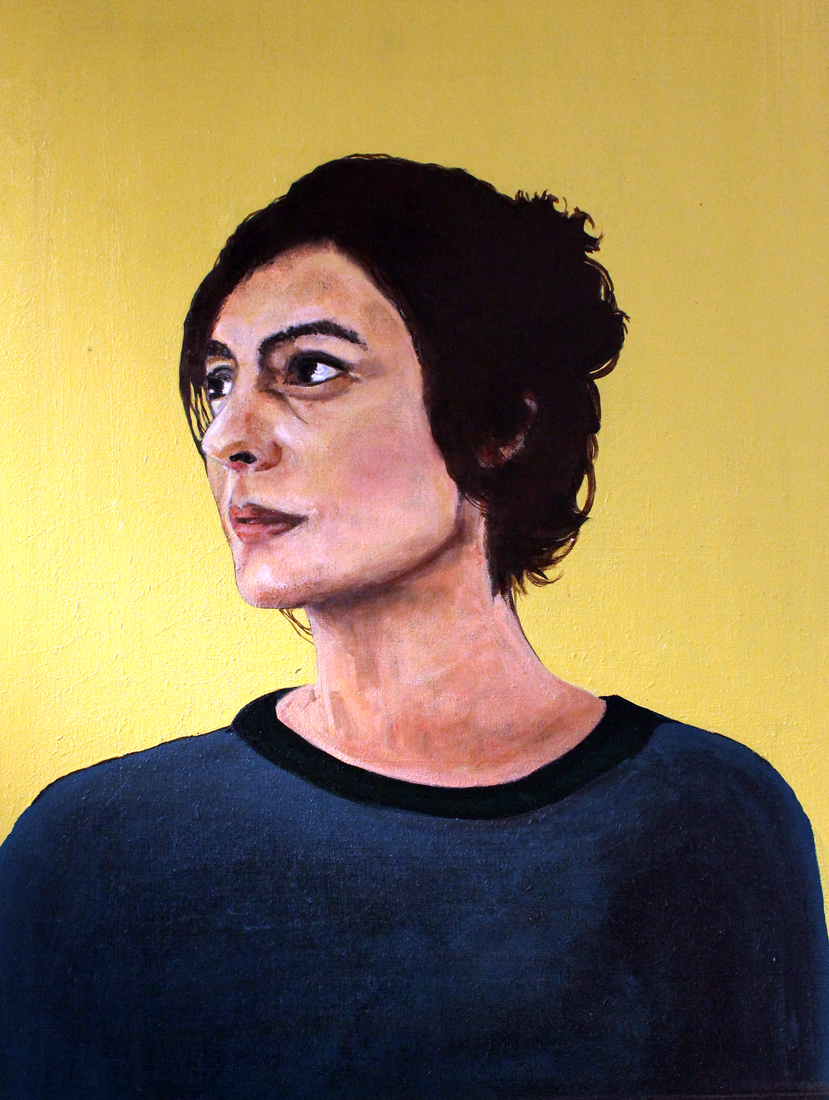
SL072, 2015 acrylic and oil on wood, 71 x 53 cm
Portraits of a Lady
Opening night rue Vernier. Having pushed open the doors of the Eva Vautier gallery, you come face to face with a large format photograph of Sandra Lecoq, from behind. In this photo, Sandra Lecoq, transfiguring her daily life, put herself on stage, by making of her workshop rags a huge patched and soiled wedding dress: the bride was in filth. She is a kind of big pole, a caryatid in the middle of a growth crisis, Alice in the land of trouble invading the space from the bottom to the top. If you were to lift her petticoat, you would see her, a smart girl, perched on top of a pile of paint modules borrowed from a 2016 photo: Haut les cœurs et bas de plafond of which Peau d’âme is a sort of inverted double. In the 2016 photo used for the group exhibition chef-orchestrated by Karim Ghelloussi, The World or Nothing, she appeared in an apron, disappearing under a pyramid of multicolored, balancing bricks. The girl in blue overalls is her, the crinoline fairground doll is still her. Worker or queen, crushed or dominating the situation, here is more than twenty years that Sandra Lecoq is married to her dirty art (dress = rag, painting = palette). In both photos, the ballroom is the humble tiled rectangle of her studio – her luxury, she says -, a module in abyme in a building where one slaughters, a hut like a classroom where each day one unlearns. It is not the space that is too low-ceilinged but the task that is immense, it is not against the walls that it bumps against something else. If Sandra Lecoq opens up her factory for a moment or two, it is not to reveal her secrets or to testify – her work has no documentary purpose – but rather to show the link that unites her to a group of artists, studio neighbors, friends, fellow travelers, a small community of musketeers-artists. Florent Mattei takes the picture for Sandra Lecoq, Karim Ghelloussi exhibits it and so on, one for all, all for one. This participative and complicit economy has notably given birth to this photograph, Peau d’âme et avanti jaddu! (the rooster in Sicilian…) which opens the new mostra of Sandra Lecoq by making the painter the model.
A reversal that is undoubtedly a key to understanding what follows. For we who enter, abandon all certainty. Let’s take each other by the hand and go to the other side. A forest of portraits, a hall of mirrors, that’s what we’re going to go through: thirty serious faces that form a strange kinship. You would arrange all around panelling, a coffered ceiling, damask paper, an oak banister you would be no less in the creaking stairwell of a mansion where the funeral faces in their gilded frames compete with the hunting trophies. How did they end up here? Let’s hang on to the railing and avanti jaddu!
The effect of surprise, not to say amazement, is multiple. We attend a retrospective of works never shown before. Only those who frequent the port district and its bars in Nice were able to see some of them anonymously in the context of a preview that never took place. When the occasional keeper of this ephemeral museum was asked, “Who are these paintings by?”, the attendant took off his cap and spilled the beans: “Sandra Lecoq”. I beg you to believe that one could read the astonishment and admiration on the faces of the curious. For it must be remembered that Sandra Lecoq’s history with painting is that of a deferred appointment, which has become almost impossible by dint of delay. What did the person concerned say? “Mother Paint implored for so long had disappointed me, too intransigent, too hard.” What did the gazette say? “With her, color is braided, sewn and made. The brush is replaced by the needle, the bits of fabric make good flat areas. Or again: “Sandra D. Lecoq belongs to a generation of artists who takes up the challenge of painting on the side of the object. If he does not use the traditional tools, supports and mediums of painting, his work proceeds well simultaneously of drawing and color.”
It would be wrong to say that Sandra D. Lecoq has never painted, it is enough to refer to the series H de guerre (2007), canvases mixing writing (swear words) and variation on pictorial gestures where the insult also meant the fight she was fighting with the paint. At the time, no one would have imagined that she would take the plunge, paint on canvas or wood, in acrylics and oils, portraits that would then be sanded, waxed, patinated and finally exhibited. However, the idea of painting has been around for twenty years. His portrait-tribute to Gérard Gasiorowki (1930-1986) could be a form of confession. She perceives in the iconoclastic and heterogeneous way of the painter having made the oblation of himself to his art, a jusqu’auboutisme which she wants to claim and which allows her today to cross this step.
In this life that is not always a gift, it took a gesture that was a gift. Like a starting signal. To a loved one, fascinated by these paintings of ancestors where the frame is often worth more than the work, she wanted one day to offer a portrait, a beautiful family portrait. Lacking the means, she set about it, like a grown-up. Love is a good guide and in art, intuition can take the place of technique. That day, in the secrecy of the studio, she found the impetus, soon followed by the gesture of painting. Yes, she did, and then she tried again and again.
With the exception of two or three portraits born of her imagination, including this guy, supposedly inspired by Florent Mattei, as pleasant as an Amish peasant in the Grant Wood style, Sandra Lecoq paints her portraits from photos, photos of relatives or taken from books and the Net. A photo, that is to say a small piece of abstraction that it will reveal. And so she threw herself wholeheartedly into the adventure of portraiture, instinctively, with her own way of painting, which, although not conceptual, is not entirely non-conceptual either. To make her portraits, she did not want to learn the technique of portraiture as she did not want to study the history of the Fayum to our days to make an intelligent statement about the art of portraiture to her advantage. Anyway, she does everything wrong, it’s in her nature. She says she does and then thinks about it. What can I say, some people read the entire manual and others prefer to press all the buttons. It doesn’t always work, but when it does, what a blast, what a party. The other side of the coin: the victory of intuition forces us each time to start almost from scratch, to try again and again, the sun that rises during the day to plunge below the horizon in the evening, such is Sisyphus.
The adventure began almost two years ago and it is not finished, we are only at the first season of a new series. You better like it because you could be in for a long time. Sandra Lecoq’s work knows no breaks, no periods, no pink, blue, brown periods, if she interrupts her work, she never cuts the thread completely and picks up her work where she left off, without bursts or effects of announcement, without tralala, she has no time, she is a hard worker. She calls herself wild but she can be worldly, like you and me, she likes to keep quiet as much as she likes to talk a lot. In any case, she is too modest or immodest to recognize any quality in herself. If we take the liberty of talking about her here, it is not to sketch her portrait but to remind us that we are not far from a contradiction and that the contradiction in itself can be a subject: the others.
A Family in Black is a visual game, the reality show of the artist, in the sense of a work of telepathy and sympathy, which means that we are the sum of the others. (Who doubted it?) In this Self-portrait of others – A nod to Gertrude Stein, where Lecoq-Toklas disappears and multiplies herself to better share her echo chamber – we are free to admire without hindrance, to pay homage, to celebrate, free to love our family or to choose another, to belong to a whole, to melt into it or to say fuck it. The brain is a trunk full of people. The others are in the head of the author and the painted faces a game of reflections of the conscience. The result: thirty or so paintings, almost all shrouded in black, a string of saturnine portraits that bar a dark line on the walls that whiteness defends. Thirty medallions who, on their own, look at each other, roll their eyes and in their night talk to each other.
Thirty glorious men and women, it would be necessary to name them all, we will not do it, they are designated here only by their number. After all, what is our name? Lecoq, She knows it at
ass (2007), does it speak to you? Among them, some were born in the 19th century, like the father of psychoanalysis(SF 0056) or the author of La Traversée des apparences(VW 0082), the youngest is 17 years old, he is the son of the artist(LD 099). But on each of these portraits, the light of an uncertain time sparkles. It is a dislocated group portrait: around the table, the eras, the ages, the sexes, the races have fixed an appointment by the sole will of the painter. Don’t you think that the men in black of a Fantin-Latour have more to say separately than together? (By the way, do we ever see all of his paintings?) The portraits are mirrors that deepen the spatial and temporal perspective. Their juxtaposition in number makes that one escapes linearity of time, it is more an accidental sum of universes, territories and destinies. We thus pass from the living to the dead, from the imaginary to the real. These realistic portraits, some of which even take up iconic and overused representations (Lacan, Kahlo, Cassavetes, Woolf, Pasolini), are, by force of circumstance, a departure from reality, the painter paints what he sees. It also comes from the fact that Sandra Lecoq’s mirrors, let’s call them portraits, are instruments of desire – yes, the eternal (and losing) battle between Eros and Thanatos. It emerges a very particular eroticism in clothes, especially for the one who, in addition, has never been afraid to show her very soft thing (2008), of Penis Carpets (years of practice!), the eventful interpenetration of Phallus and Vanity (2008) or all the folklore of Le Vit en rose (2007) which earned the culprit to be censored.
The mirror of others is an opportunity to look at oneself, to introspect, to become aware. A political awareness as well. There is Simone Weil(SV 027): abortion. Cédric Herrou(CH 079): the farmer of the Roya, smuggler and symbol of aid to migrants. Leoluca Orlando(LO 047): the master of Palermo opening his door to refugees in a closed Europe. There is Pasolini(PPP 022). Sandra Lecoq’s African Orestie is set in Cameroon, where she was born in 1972, and takes on the tragic traits of Ruben Um Nyobe (RUN 013), assassinated in 1958 (age 45) by the French army, and Félix-Roland Moumié (FRM 025), assassinated in 1960 (35 years old) by the French secret services, two figures of the struggle for independence. She did not know these leaders any more than the young dead Eva Hesse(EH 036) or the almost centenarian Louise Bourgeois(LB 011), but they are also her story.
This group portrait or this group in portraits, is finally the opportunity, ten years later, to decline an experience that had struck the spirits in Nice, the exhibition of the Dojo: Delicious exquisite cadavers or the story of a holy family recomposed. An event greeted in these terms by Jean-Marc Réol:
“No trace here of a thematic presentation on a question of the actuality of the art, no socio-historical interrogation on the political role of the artists, but rather the expression, alternately playful and enthusiastic, of a desire to expose the link which unites a group of artist, on an essentially affective and playful mode. To this “holy family” belonged Noël Dolla, Roland Flexner, Philippe Mayaux, Pascal Pinaud, Philippe Ramette, Olivier Bartoletti, Karim Ghelloussi. ND 045, RF 044, PM 061, PP 064, PR 061, OB 073, KG 077: they are all here in paint in this conversation piece. The curator of the 2006 exhibition has found in 2017 the art and the way to bring her little world together again.
June evening, after a glass of Ben’s jaja, the temperature rises a notch. These 15 x 21 invitation cards are very practical fans: on the front, a photo of the artist’s back, the artist’s back has been made into a canvas and frame, his youngest son draws a chick on the skin, unless it is a rooster, while the eldest son takes the photo. The whole is a self-portrait of the author made in family. Black has turned to gold.
FM 067



